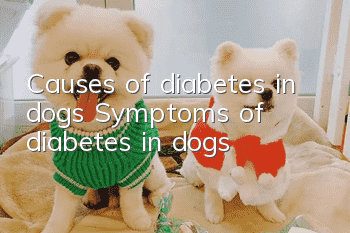Causes of diabetes in dogs Symptoms of diabetes in dogs

Causes of dog diabetes
1. The direct cause is insufficient secretion of insulin, the endocrine secretion of the dog pancreas.2. Liver disease prevents glycogen from accumulating.
3. The sugar center in the medulla oblongata is stimulated and blood sugar increases.
4. Diseases of the adrenal gland, thyroid, and pituitary gland will increase blood sugar when their functions become hyperactive.
5. Sedatives, anesthetics, thiazides, phenytoin and other drugs affect the release of insulin.
Symptoms of diabetes in dogs
1. When a dog has diabetes, the main symptoms are irritability, thirst, polyuria, gluttony, weakness and weight loss;2. When the sick dog’s condition is serious At this time, the exhaled breath smells like rotten apples. If the disease progresses further, vomiting and bloody diarrhea may occur, which may lead to acidosis and eventually diabetic coma;
3. Blood sugar increases. In dogs, it is usually 75-120 mg/100 ml. In this disease, it increases to 150 mg/100 mg/100 ml. 100 ml, sometimes even up to 400 mg/100 ml;
4. In the final stage, it can cause corneal ulcers, cataracts, vitreous opacity, omental detachment, blindness, skin ulcers, hair loss, heart failure, and even coma.
How to deal with dog diabetes
1. The treatment principle of this disease is to lower the dog’s blood sugar and correct the water, electrolyte and acid-base balance disorders.2. Send the dog to the hospital for diagnosis and treatment in a timely manner, and take medicine on time according to the veterinarian's instructions for long-term treatment.
3. Feed therapy is the basic treatment method for canine diabetes. The principle is to give low-carb foods, such as meat, milk, etc.; supplement with sufficient amounts of B vitamins; feed regularly and quantitatively, in small amounts many times.
4. Those who urgently need to control hyperglycemia and correct metabolic disorders should use fast-acting insulin; while those with stable conditions generally use long-acting or intermediate-acting insulin.
5. Oral hypoglycemic drugs. Commonly used drugs include phenylcyclohexylurea acetate, chlorpropamide, tolbutamide, and hypoglycemic drugs. It is generally limited to sick dogs whose blood sugar does not exceed 200 mg per 100 ml and is not accompanied by ketonemia.
6. Insulin therapy, half an hour before morning feeding, subcutaneously inject 0.5 micrograms/kg body weight of intermediate-acting insulin once a day. For sick dogs with ketoacidosis, crystallized insulin or semi-slow insulin zinc suspension can be used, with low-dose continuous intravenous infusion or low-dose intramuscular injection. The intravenous injection dose is 0.1 μg/kg body weight, and the intramuscular injection dose is 0.1 μg/kg body weight. 1 microgram for more than 3 kilograms and 2 micrograms for less than 10 kilograms.
7. For fluid therapy, you can choose lactated Ringer's solution, 0.45% sodium chloride solution and 5% glucose solution. The amount of intravenous fluid should generally not exceed 90 ml/kg of body weight. You can first inject 20-30 ml/kg of body weight, and then inject slowly. And timely supplement potassium salt.
Random articles
- What do dogs eat to protect their stomach? It is important to protect their stomach and treat gastrointestinal diseases in dogs.
- How to tell if your dog is fat? Is your dog overweight?
- Will your dog catch a cold if you blow the air conditioner? What should you do if your dog catches a cold if you blow the air conditioner?
- What should you pay attention to when your dog drinks water? Don’t be careless when it comes to your dog’s drinking water.
- The dog's mouth bites and shakes. Why does the dog's mouth occasionally shake and bite?
- How to cut a dog's hair? Do you know how to cut a dog's hair correctly?
- Can dogs eat raw eggs? Why can’t dogs eat egg whites?
- Common Dog Problems in Summer How to Deal with Different Dog Problems
- How to keep dogs away from skin diseases. If you do this, will you see if your dog will still be infected with skin diseases?
- What causes anorexia in dogs? Dogs will become anorexic due to lack of exercise. Hounds run at least 5KM every day.



